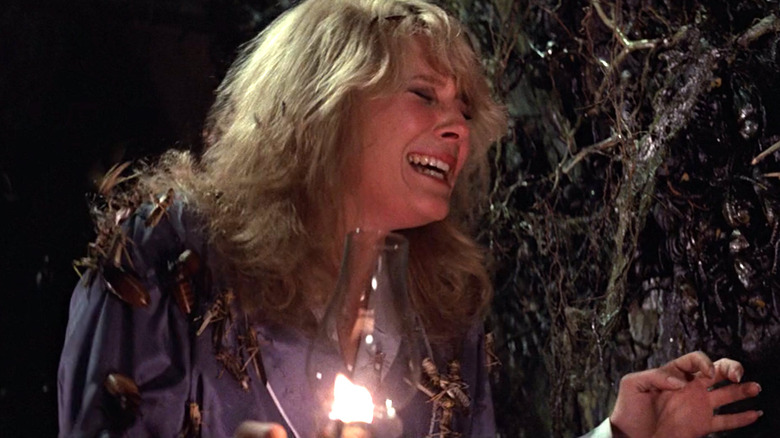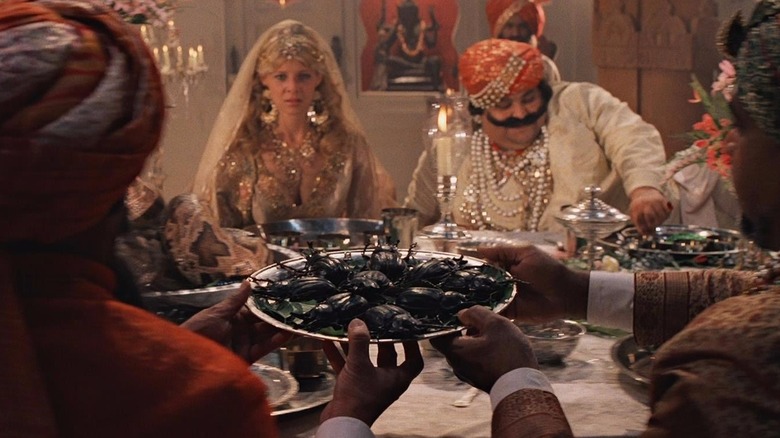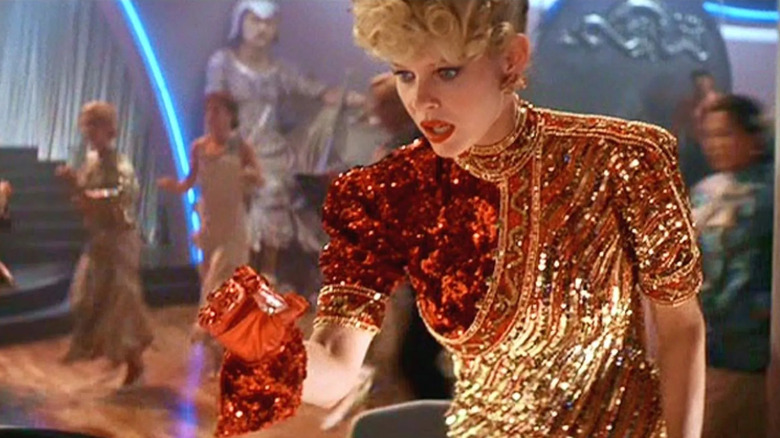Kate Capshaw Had To Self-Medicate Before Indiana Jones And The Temple Of Doom's Bug-Filled Scene
Steven Spielberg's 1984 film "Indiana Jones and the Temple of Doom" features more murders than any of the other films in the Indiana Jones series. Jones (Harrison Ford) is personally responsible for at least 21 deaths. Additionally, the film features a scene of a man getting his heart pulled out of his chest, that same man being burned up in a lava pit while screaming for his life, a scene of a man being smooshed alive in a rock crusher, at least 100,000 human skulls, extensive images of child slavery, and a scene wherein the protagonists have to crawl through a damp corridor coated on all sides by gigantic beetles and cockroaches. The film is rated PG. Enjoy the movie magic, kids! It's no wonder that the MPAA decided to implement a PG-13 rating shortly after this film's release.
Despite all the violence, some audience members — the entomophobia sufferers in particular — were most disturbed by that bug scene. Notably, when Willie Scott (Kate Capshaw) crawls through the corridor wearing silk pajamas. She complains that she broke a nail, realizes something is on her palm, turns her hand over, and is confronted with a five-inch long giant prickly stick insect clinging to her. She freaks out. She looks around and finally sees the hundreds of Hercules beetles, harlequin beetles, phasmids, and whistling cockroaches clinging to the walls — and to her pajamas. Ew, ew, ew.
To film the scene, Capshaw actually had to handle the insects in question; that's really her hand holding a real stick insect. Spielberg also coated her silk pajamas in real, live cockroaches, and Capshaw had to spend hours interacting with piles of creepy crawlies.
In a home-video-exclusive behind-the-scenes documentary, Capshaw admits she didn't go to the set sober that day.
Buckets of bugs
In a cute exchange between Kate Capshaw and Spielberg, the actress mock-cried when she saw the bugs. Spielberg turns to the camera and smirks that she promised she would do the bug scene if she opted out of doing "the snakes." Capshaw immediately stops crying, smiles, and says she'll "do the bugs." That doesn't mean, however, that she wasn't supremely creeped out at the prospect. In an interview, Capshaw even wondered if she should take something — maybe get high — before shooting the scene just so she wouldn't be too afraid while being coated with enormous insects. She said:
"I was really asking people: is there a pill? There must be something I can take to keep myself from freaking out. I don't want everyone to look at the movie and say 'She's on drugs!' But I did take something that was like a relaxant."
Because of the unnamed relaxant, Capshaw was in a much more amenable mood when it came to being coated with bugs. She recalled her mood on the day of shooting, and how the chemicals in her system allowed her to accept the difficult cockroach-related task. There were several buckets involved. She said:
"I came to the set, and I was like [languid] 'Hi, Steven!' He said 'We're gonna do the bugs.' I said [languid] 'Okay.' He said 'I'll stand with you.' [languid] 'Okay.' He said 'Stand here and we're gonna pour some bugs on top of you.' [languid] 'Alright. Where will they be coming from?' 'Well, we're gonna pour a bunch of buckets of bugs from up above you ... it's gonna be several buckets.' [languid] 'Okay.' That's how I was the entire day."
Kudos to Capshaw for gutting it out.
Fun bug facts!
The cockroach corridor scene was, of course, a payoff for a scene earlier in the movie when Capshaw was served giant beetles as a delicacy at a high-end, exotic meal that also featured live snakes, eyeball soup, and chilled monkey brains. Despite all the gross scenes in "Temple of Doom," Capshaw and Spielberg would marry in 1991.
The bug scene in "Temple of Doom" was, as any entomologist will tell you, biologically incorrect. The website Green Pest Services pointed out that none of the beetles in the scene are native to India where the film takes place. The giant prickly stick insect, for instance, is native to Australia and New Guinea. It seems unlikely that the Maharaja of Pankot would bother to import Australian insects just to occupy a mysterious hidden corridor that leads to a skull-crushing room (and, come to think of it, why is there a skull-crushing room at all?).
The stick-like phasmids are common on every continent (except Antarctica) and are plentiful in India. They are not poisonous or harmful to humans. The giant whistling cockroaches actually do hiss at predators, although they are most common in Madagascar. Harlequin beetles, meanwhile — the ones with really, really long front legs and antennae — are native to Mexico. They tend to eat rotting wood and animal excrement. These ones can actually bite. Native to Sri Lanka are the Hercules beetles, which are the ones with rhinoceros-like horns on its face. Its jaws are very strong, and larger Hercules beetles can crush an aluminum can. Their pinches can hurt, but they aren't harmful.
Capshaw did not report being bitten. She was certainly feeling no pain.


